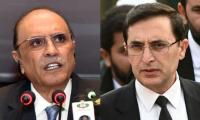Spring is a time of health, joy and energy. This time around, however, it is visibly desolate and dreary. The usual abundance of vegetation, fresh air, and flowers has been bedeviled by the dreadful Covid-19.
We know for a fact that wars, diseases and famines have ravaged civilizations, deserted towns and perished cities, but somehow this spring will particularly remain a grim reminder of how vulnerable human beings are, despite their spectacular advances in medical sciences, to disease. The post Covid-19 world is likely to be different in more than one way.
Covid-19 has created a public health crisis of enormous proportions worldwide, Pakistan being no exception. Both in the developed and in the under-developed world, healthcare systems were caught unprepared to adequately respond. In the context of Pakistan, given the highly contagious nature of Covid-19, providing intensive care to the affected – with less than 3000 ventilators – would be next to impossible.
The enormity of the challenge demands extraordinary response, at the policy, institutional and implementation levels. At the highest policy level, it is rather surprising that health is still not recognized as a fundamental right under the 1973 constitution of Pakistan. Article 9 of the constitution is related to the fundamental right to life. In the absence of an express article in the constitution envisaging health as a fundamental right, this article is often interpreted as covering the fundamental right to health also. More specifically, medical relief is mentioned in Article 38 in the Principles of Policy. However, that article makes medical relief contingent on the availability of resources.
The UN Human Rights Declaration (1948) declared health as a fundamental right. The WHO constitution also envisages “the highest attainable standard of health as a fundamental right of every human being”. Pakistan is also committed to Universal Health Coverage (UHC) under Sustainable Development Goal 3.
The implications of this policy gap are not less significant. In the WHO report titled ‘Health at a Glance: Asia Pacific 2018’, Pakistan’s health indicators are seen as among the worst in the regional and peer economies. The Global HDI Report 2019 clearly places Pakistan way behind India and Bangladesh, even the average of the entire South Asia, in terms of HDI. Its health spending, a paltry 2.8 percent of GDP, is far below the WHO standards. We have one doctor for 963 persons, one dentist for 9,413 persons and one bed for 1068 persons.
Institutional overlap, resistance to reform, turf war and inadequate coordination are no less significant factors hampering the provision of quality health services in Pakistan, especially in the post 18th Amendment dispensation. To make matters worse, at the operational level, Pakistan’s current health system is not providing ‘value for money’ even for the existing resources, and is inefficient, ineffective, less accountable, and often non-responsive.
Covid-19 has indeed posed a plethora of challenges, but it has also provided an opportunity to revamp the outdated system for a healthy and prosperous nation. This opportunity calls for action at the policy, institutional and operational levels. Pakistan can organize and finance its healthcare system in light of the regional and global experiences. SDG Target 3.8 requires all countries to “achieve UHC including financial risk protection”.
In Pakistan the predominant mode is 70 percent out-of-pocket health spending, the most inequitable of all. The National Health Service in the UK is financed mainly through general taxation while in the US health is financed mostly through private health insurance, leaving 30 million uninsured. Austria, Germany, and South Korea have organized financing predominately through premiums-based system (SHI), that hinges on the solidarity principle where payment is according to ability to pay and service is according to the needs. These countries have been relatively more successful in handling the pandemic than the for-profit private finance model of America.
Pakistan’s current health model is partially financed through general taxation, but 70 percent of people pay out-of-pocket at the point of service. This taxation model is regressive with over 60 percent taxes indirectly hitting the poor. Further, due to elite capture, the salaried middle class end up paying.
Given the low capacity in taxation system, that too regressive in nature, the premium-based system of SHI is considered by experts to be a viable and sustainable option for Pakistan. Many developing countries including Rwanda and Nigeria are implementing such pre-payment pooling/ SHI arrangements so that no one faces financially unbearable hardships at the point of service. In 2006, the health department in KP had worked on an SHI model, starting from government employees, with the technical assistance of GIZ in consultation with religious scholars. Unfortunately, the project was shelved by the succeeding government.
At the highest policy level, the challenge of Covid-19 beacons us to move towards categorically declaring health as a fundamental right in the constitution of Pakistan. The development of a robust decentralized state-of-the-art health care delivery system and financing based on the solidarity principle of SHI would not only lead to a healthy population but also sustained economic growth and an egalitarian social order. Will those in the power corridors pay heed to this pressing issue of the people of Pakistan?
The writer is former senior minister LG and health minister, Kyber Pakhtunkhwa.
Email: Inayatullahnwfp@gmail.com
Twitter: Inayat01
A woman walks past a building of the International Monetary Fund. — AFP/FileThe annual and spring meetings of the...
Late Benazir Bhutto's daughter Asifa Bhutto Zardari addresses the Christian community in Bihar Colony on January 23,...
Representational image. — PexelsWater is an important scarce natural resource that is required for several everyday...
Pakistani employees of online marketplace company Kaymu at work in Karachi. — AFP/FileThe true spirit of development...
India uses Afghanistan as a backstage area to carry out terrorist attacks against Pakistan
Another report by the Pakistan Institute of Peace Studies states that 78 per cent of attacks have been carried out by...







